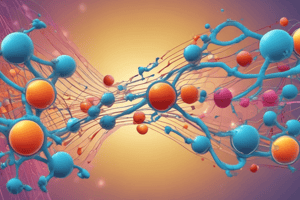Podcast
Questions and Answers
What type of data does quantitative research primarily involve?
What type of data does quantitative research primarily involve?
- Textual data
- Subjective data
- Random data
- Numerical data (correct)
Qualitative research relies solely on numerical data for analysis.
Qualitative research relies solely on numerical data for analysis.
False (B)
Identify one common method used in qualitative research.
Identify one common method used in qualitative research.
Interviews
The main purpose of ______ research is to test hypotheses and examine causal relationships.
The main purpose of ______ research is to test hypotheses and examine causal relationships.
Match the research methods with their characteristics:
Match the research methods with their characteristics:
Which of the following is NOT a characteristic of quantitative research?
Which of the following is NOT a characteristic of quantitative research?
Quantitative research is more focused on the meaning and context of human behavior than qualitative research.
Quantitative research is more focused on the meaning and context of human behavior than qualitative research.
What is the primary advantage of using surveys in quantitative research?
What is the primary advantage of using surveys in quantitative research?
What is the primary function of ATP in biological processes?
What is the primary function of ATP in biological processes?
Glucose is generated from the breakdown of ATP.
Glucose is generated from the breakdown of ATP.
What substance is primarily broken down to produce ATP?
What substance is primarily broken down to produce ATP?
Cells use ATP to _____ energy for various metabolic processes.
Cells use ATP to _____ energy for various metabolic processes.
Match the following terms with their definitions:
Match the following terms with their definitions:
What process involves breaking down glucose to produce ATP?
What process involves breaking down glucose to produce ATP?
ATP is produced during the fermentation process.
ATP is produced during the fermentation process.
Name one type of process where ATP is crucial.
Name one type of process where ATP is crucial.
What is a potential impact of excessive screen time?
What is a potential impact of excessive screen time?
All screen time is harmful regardless of content.
All screen time is harmful regardless of content.
Name one benefit of educational screen use.
Name one benefit of educational screen use.
Excessive screen time can lead to __________ issues.
Excessive screen time can lead to __________ issues.
Match the following outcomes to their related causes:
Match the following outcomes to their related causes:
Which of the following is an effective way to reduce screen time?
Which of the following is an effective way to reduce screen time?
Taking regular breaks from screens can benefit your health.
Taking regular breaks from screens can benefit your health.
What is one suggested duration for taking screen breaks?
What is one suggested duration for taking screen breaks?
Which of the following statements is true about data structures?
Which of the following statements is true about data structures?
Arrays are considered a type of linear data structure.
Arrays are considered a type of linear data structure.
What is the primary purpose of a stack data structure?
What is the primary purpose of a stack data structure?
In a queue, elements are added at the ______ and removed from the ______.
In a queue, elements are added at the ______ and removed from the ______.
Match the following types of data structures with their correct characteristics:
Match the following types of data structures with their correct characteristics:
Which of these data structures is used for implementing recursive algorithms?
Which of these data structures is used for implementing recursive algorithms?
A binary tree can have more than two children per node.
A binary tree can have more than two children per node.
What does the term 'hashing' refer to in data structures?
What does the term 'hashing' refer to in data structures?
What is the primary purpose of data visualization?
What is the primary purpose of data visualization?
Data visualization is only beneficial for expert data analysts.
Data visualization is only beneficial for expert data analysts.
Name one common type of data visualization.
Name one common type of data visualization.
_______ charts are used to show trends over time.
_______ charts are used to show trends over time.
Match the following types of charts with their respective uses:
Match the following types of charts with their respective uses:
Which of the following is a benefit of using data visualization?
Which of the following is a benefit of using data visualization?
Interactive visualizations allow users to engage with the data.
Interactive visualizations allow users to engage with the data.
What is the advantage of using color in data visualization?
What is the advantage of using color in data visualization?
Flashcards are hidden until you start studying
Study Notes
Cellular Respiration
- Cellular respiration is the process by which cells break down glucose and other food molecules to generate ATP, the primary energy currency of the cell.
Stages of Cellular Respiration
- There are four main stages:
- Glycolysis: Glucose is broken down into pyruvate, producing a small amount of ATP and NADH. This occurs in the cytoplasm.
- Pyruvate Oxidation: Pyruvate is converted to acetyl-CoA, generating more NADH. This occurs in the mitochondrial matrix.
- Citric Acid Cycle (Krebs Cycle): Acetyl-CoA is broken down, releasing CO2 and generating more ATP, NADH, and FADH2. This occurs in the mitochondrial matrix.
- Electron Transport Chain: The high-energy electrons carried by NADH and FADH2 are passed along a series of protein complexes, creating a proton gradient across the inner mitochondrial membrane. This gradient is used to generate a large amount of ATP through oxidative phosphorylation. This process occurs in the inner mitochondrial membrane.
ATP Production
- The breakdown of one glucose molecule can yield up to 38 ATP molecules.
- Most of the ATP is generated through oxidative phosphorylation in the electron transport chain.
Regulation of Cell Respiration
- The rate of cellular respiration is tightly regulated to meet the energy needs of the cell.
- Factors that can influence the rate of respiration include:
- The availability of glucose and oxygen
- The concentration of ATP and ADP
- Hormonal signals
Studying That Suits You
Use AI to generate personalized quizzes and flashcards to suit your learning preferences.




